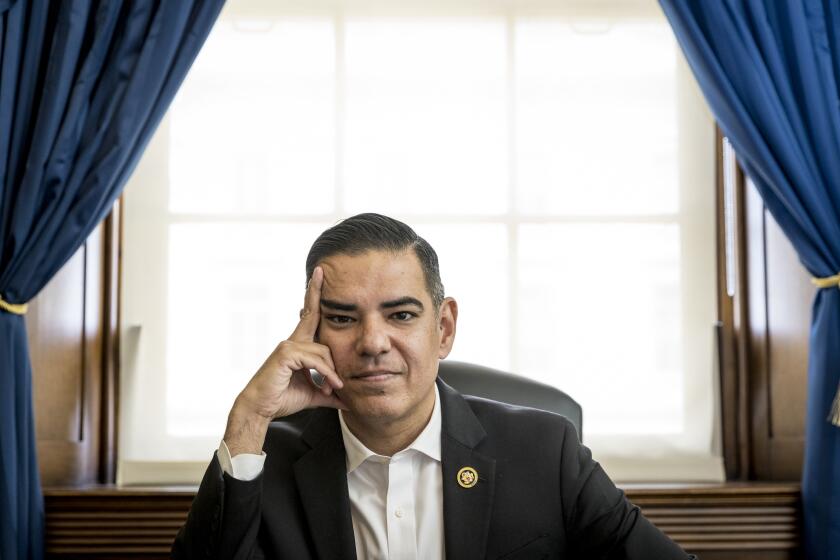California’s Chief Justice Warns Against Budget Cuts
Ronald M. George, chief justice of California, told a joint session of the California Legislature this week that threatened budget cuts could cripple the ability of the state court system to deliver justice. Another year of budget reductions poses challenges to both the civil and the criminal courts, George said. Excerpts from his talk:
A strong and independent judicial system is not just another government program, nor is it a luxury to be afforded in good economic times and neglected when the state’s revenues are down. To understand the significance of a strong and independent judicial system, we need look no further than the United States Supreme Court’s decision in Brown vs. Board of Education, whose 50th anniversary we celebrate this year....
The legacy of the momentous decision in Brown vs. Board of Education should remind us of what it would be like to have a court system in which basic civil rights issues cannot be decided. That is not unthinkable....
Our nation and our state were founded on the basic principle of liberty and justice for all. That principle cannot be realized if our courts cannot function and provide fair and accessible justice.
California’s court system -- the largest in the nation, with more than 1,600 judges, several hundred subordinate judicial officers and about 19,000 court employees -- has been working hard to meet its basic obligations to the public and to our sister branches of government.
We are continuing to do our part in reducing expenditures wherever possible. Already, however, reductions in court budgets have adversely affected the lives of many Californians, and threaten to render the administration of justice uneven and inadequate across our state....
In short, cutting the courts now will result in greater costs to government later. An under-funded judicial system also will impede our state’s economic recovery. If civil cases cannot be resolved in a reasonable time, or if court services decline so that public safety and security suffer, business establishments and individuals simply will go elsewhere....
Despite our hard work and our commitment to retain employees in order to keep our courts open, the strain on our judicial system caused by inadequate resources already has begun to adversely affect public safety, families and self-represented litigants, as well as the stable court environment needed to create confidence in the business sector....
Existing and threatened reductions will destroy the powerful momentum that has greatly enhanced the judicial system’s ability to provide meaningful access to justice for all Californians.
Let me offer a few examples of recent accomplishments. Jury reform has been a major goal, focusing on improving the participation of all who qualify and making their contributions less onerous and more meaningful. The change to one-day-or-one-trial jury service, as opposed to sitting in the jury assembly room for up to two weeks, has been a great success.
Just last fall, the Judicial Council adopted a two-volume set containing hundreds of plain-English instructions developed over the last several years by the Council’s Task Force on Jury Instructions. Used by judges in California’s courtrooms to instruct jurors on the law in civil cases, they have been made available free of charge on the judicial branch’s website....
In a parallel effort, the redrafting of the California Rules of Court, the first such comprehensive revision since the 1930s, is well underway -- a project led by a committee chaired by my colleague Justice Joyce Kennard....
Great Challenges
This is a time of extraordinary challenges to the administration of justice in California. Our society has undergone vast changes. Today, more than 100 languages are translated in our courtrooms. In many courts, more than 80% of those seeking a divorce do not have an attorney. More than 90% of those seeking domestic-violence restraining orders appear in court without legal representation, and the same percentage applies to tenants in landlord-tenant disputes. And cases spanning multiple jurisdictions with classes of hundreds -- if not thousands -- of parties now are a common sight in our metropolitan courts.
In response to these challenges, positive changes have flourished in courthouses and communities up and down the state of California. Through your appropriations creating the Equal Access Fund, an unprecedented array of resources has become available to assist self-represented litigants. Family law facilitators and legal aid assistance in the courthouses are there to help these individuals cope with the unfamiliar world of legal documents.
Self-help kiosks in courthouse hallways provide step-by-step guidance in filling out forms. Workshops led by legal services lawyers and supervised volunteers enable litigants to navigate child support, landlord-tenant, guardianship, and small claims matters.
And the complex litigation pilot project in six courts has proved very successful. There have been millions of hits on the court system’s website....
Nevertheless, although the judicial system persists in efforts to provide meaningful access to the courts, we are finding that many useful programs are being curtailed and are in immediate jeopardy of being eliminated entirely, because of cuts already imposed or reductions proposed for the coming fiscal year. The consequences of such under-funding also extend to core court functions that directly affect public safety....
Effect on Safety
In Ventura County, arrest warrants are taking twice as long to process, impacting public safety. Prosecutors and defense counsel cannot obtain current information on defendants who are before the court. In short, incorrect or incomplete information increases the danger to the public. And individuals who have cleared outstanding warrants risk being stopped, arrested and having their vehicles impounded because of stale information....
Security Also an Issue
Courthouse security also has been affected. In Stanislaus County, for example, the armed security force has been reduced by three full-time deputies at a time when the number of trials for violent crimes has increased. The basic ability of courts to remain open for the people’s business is being weakened by chronic underfunding. In Riverside, three court locations have been closed. In Los Angeles, 29 courtrooms already have been shut down....
Out of the 12 million residents of Los Angeles County, one out of every two comes through the doors of at least one of the dozens of courthouses of the Los Angeles County Superior Court every year as a litigant, a lawyer, a witness, a juror, a member of the public seeking information, or an employee.
What other public service or facility is used to such an extraordinary degree?
Some courts have shortened the public hours of clerks’ offices, making it harder for individuals to file documents or obtain information. Some pressing matters are delayed -- including potential life-saving measures such as obtaining a domestic violence or other restraining order -- because long waits for service by court users, at times extending for days, have become common. In Riverside County, budget cuts already have doubled the time it takes to obtain a family law mediation appointment -- a critical step in resolving custody and other disputes -- from 45 days to 90 days following the initial filing....
In Santa Cruz, night traffic court is being canceled until the end of the fiscal year. In Monterey, the court attorney specializing in domestic violence cases is unable to process documents in a timely manner because of a reduction in clerical staff -- resulting not only in delays but also in the issuance of conflicting orders concerning children.
In Ventura County, the Superior Court’s Self-Help Legal Access Centers have had to cut back on community outreach services that use their mobile van self-help center, due to the cost of fuel, maintenance, and staffing....
The juvenile dependency and family law drug courts focus on reunifying families. Already, however, there is a three- to six-month wait to enter a drug court treatment program.
Children who cannot be reunited with substance-abusing parents must be placed in care outside the home -- costing approximately $5,300 a month. That ... would support a parent’s participation for an entire year in drug court and related treatment programs.
I cannot emphasize too strongly how firmly I believe that further cuts to our courts will not achieve net savings; instead, they will increase the overall costs for our society.
Inadequate funding for drug courts and treatment services will shift costs to the prison and social services systems as individuals fail to obtain the help they need and they and their families suffer the consequences. Civil litigants -- including firms doing business in California -- will be confronted with increasingly scarce court services, complicating and delaying the resolution of their disputes. Courts facing current financial difficulties are contemplating shutting down civil courtrooms for part of each week -- if not for part of the year....
Courts cannot control the number of cases filed. They cannot reach out to the public at large to collect fees to support their operations....
The cost of a functioning justice system should be paid by everyone, not simply by direct users; all of us benefit from the fair, accessible, and efficient administration of justice....
One measure of a society is its ability to ensure public order and security while protecting the rights of the individual, no matter how weak or powerful.
Courts stand at the forefront of this endeavor. If we abandon the goal of accessible justice for all, we surrender not only our court system, but one of the most fundamental compacts of our democratic system of government.
More to Read
Get the L.A. Times Politics newsletter
Deeply reported insights into legislation, politics and policy from Sacramento, Washington and beyond. In your inbox three times per week.
You may occasionally receive promotional content from the Los Angeles Times.










